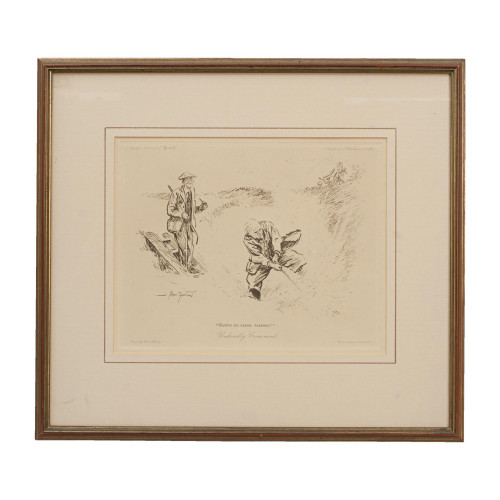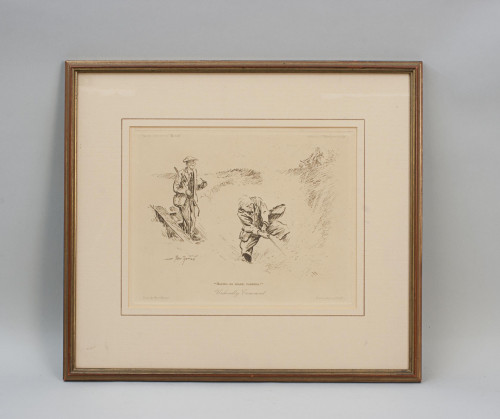- Home
- Golf
- Artwork, Paintings & Prints
- Golf Print, Cock Of The Green - Alexander McKellar
Golf Print, Cock Of The Green - Alexander McKellar
Golf Print, Cock Of The Green - Alexander McKellar
29881
John Kay Etching, Cock of the Green.
An original framed portrait etching of Alexander McKellar, the "Cock o' the Green" by John Kay. a Scottish caricaturist and engraver. The picture depicts Alexander McKellar with his long nose golf club setting up to hit the golf ball. A selection of long nose club lay on the floor beside him, text accompanying the image 'By the La' Harry, this shall not go for Nothing, Cock Of The Green, J Kay 1803'.
Alexander McKellar, the "Cock o' the Green" was obessed by golf spending most of his time on Bruntsfield Links. When not playing golf McKellar served as a doorkeeper at an epsicopalian chapel in Edinburgh on Sundays.
From Wikipedia:-
John Kay was born in April 1742 in Gibraltar Cottage just south of Dalkeith, Scotland, where his father, John Kay, worked as a mason. His mother, Helen Alexander, owned several properties in Edinburgh and the Canongate and was relatively wealthy. When his father died in 1748, John was sent to live in Leith, the harbour area of Edinburgh, with some of her relatives, who treated him very badly. At age 13 he returned to Dalkeith where he was apprenticed to George Heriot, a barber in the town, whom he served for six years.
In 1761 he went to Edinburgh, where he served 7 years as a journeyman but not being an Edinburgh citizen had to purchase the freedom to trade as a barber from the Society of Surgeon-Barbers, which he eventually did in December 1771 at age 29, on payment of £40. He then set up business on the High Street in Edinburgh. He had several high ranking clients and made friends with several, notably William Nisbet of Dirleton who became a constant companion.
In 1784 he began engraving his drawings and published his first caricature: James Robertson of Kincraigie, "the daft highland laird". In 1785, induced by the favour which greeted certain attempts of his to etch in aquafortis, he took down his barber's pole and opened a small print shop in Parliament Close. There he continued to flourish, painting miniatures, and publishing at short intervals his sketches and caricatures of local celebrities and oddities, who abounded at that period in Edinburgh society. From 1785 he abandoned his business as barber to concentrate on drawing. This was facilitated by annuities paid to him by Sir Henry Jardine and the estate of William Nisbet.
Kay's portraits were collected by Hugh Paton and published under the title A series of original portraits and caricature etchings by the late John Kay, with biographical sketches and illustrative anecdotes (Edinburgh, 2 vols. 4to, 1838; 8vo ed., 4 vols., 1842; new 4to ed., with additional plates, 2 vols., 1877), forming a unique record of the social life and popular habits of Edinburgh at its most interesting epoch. Kay's famous shop on the Royal Mile was destroyed during the Great Edinburgh Fire of November 1824.
He died at 227 High Street in Edinburgh and was buried at the north-west corner of Greyfriars Kirkyard. The British Museum has extensive holdings of his works, including two albums apparently assembled by Kay.
Dimensions:
1800-1849
1803
Etching
United Kingdom
Good clean condition.
Thank you for your enquiry.
We will get back to you soon.
Please create wishlist to add this item to
RELATED ITEMS





























